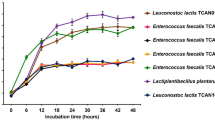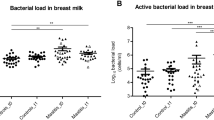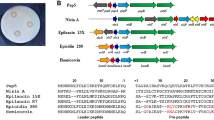Abstract
Mammalian milk possesses inherent antimicrobial properties that have been attributed to several diverse molecules. Recently, antimicrobial peptides that belong to the cathelicidin gene family have been found to be important to the mammalian immune response. This antimicrobial is expressed in several tissues and increased in neonatal skin, possibly to compensate for an immature adaptive immune response. We hypothesized that the mammary gland could produce and secrete cathelicidin onto the epithelial surface and into milk. Human cathelicidin hCAP18/LL-37 mRNA was detected in human milk cells by PCR. Quantitative real-time PCR demonstrated an increase in relative expression levels at 30 and 60 d after parturition. Immunohistochemistry of mouse breast tissue identified the murine cathelicidin-related antimicrobial peptide in lobuloacinar and ductules. Western blot analysis of human milk showed that LL-37 was secreted and present in the mature peptide form. The antimicrobial activity of LL-37 against Staphylococcus aureus, group A Streptococcus, and enteroinvasive Escherichia coli O29 in the human milk ionic environment was confirmed by solution colony-forming assay using synthetic peptide. These results indicate that cathelicidin is secreted in mammary gland and human milk, has antimicrobial activity against both Gram-positive and Gram-negative bacteria, and can contribute to the anti-infectious properties of milk.
Similar content being viewed by others
Log in or create a free account to read this content
Gain free access to this article, as well as selected content from this journal and more on nature.com
or
Abbreviations
- ACN:
-
acetonitrile
- AMS:
-
autoclaved milk supernatant
- CRAMP:
-
cathelicidin-related antimicrobial peptide
- GAS group A:
-
Streptococcus hBD human β-defensin
- hCAP18:
-
human cationic antimicrobial peptide 18
- RT-PCR:
-
reverse transcriptase–PCR
- TFA:
-
trifluoroacetic acid
References
Zasloff M 2002 Antimicrobial peptides of multicellular organisms. Nature 415: 389–395
Zaiou M, Gallo RL 2002 Cathelicidins, essential gene-encoded mammalian antibiotics. J Mol Med 80: 549–561
Panyutich A, Shi J, Boutz PL, Zhao C, Ganz T 1997 Porcine polymorphonuclear leukocytes generate extracellular microbicidal activity by elastase-mediated activation of secreted proprotegrins. Infect Immun 65: 978–985
Agerberth B, Charo J, Werr J, Olsson B, Idali F, Lindbom L, Kiessling R, Jornvall H, Wigzell H, Gudmundsson GH 2000 The human antimicrobial and chemotactic peptides LL-37 and alpha-defensins are expressed by specific lymphocyte and monocyte populations. Blood 96: 3086–3093
Tomasinsig L, Scocchi M, Di Loreto C, Artico D, Zanetti M 2002 Inducible expression of an antimicrobial peptide of the innate immunity in polymorphonuclear leukocytes. J Leukoc Biol 72: 1003–1010
Di Nardo A, Vitiello A, Gallo RL 2003 Cutting edge: mast cell antimicrobial activity is mediated by expression of cathelicidin antimicrobial peptide. J Immunol 170: 2274–2278
Schutte BC, McCray PB Jr 2002 β-Defensins in lung host defense. Annu Rev Physiol 64: 709–748
Bals R 2000 Epithelial antimicrobial peptides in host defense against infection. Respir Res 1: 141–150
Ganz T 2002 Epithelia: not just physical barriers. Proc Natl Acad Sci USA 99: 3357–3358
Lonnerdal B 2003 Nutritional and physiologic significance of human milk proteins. Am J Clin Nutr 77: 1537S–1543S
Goldman AS, Chheda S, Garofalo R 1998 Evolution of immunologic functions of the mammary gland and the postnatal development of immunity. Pediatr Res 43: 155–162
Liepke C, Zucht HD, Forssmann WG, Standker L 2001 Purification of novel peptide antibiotics from human milk. J Chromatogr B Biomed Sci Appl 752: 369–377
Jia HP, Starner T, Ackermann M, Kirby P, Tack BF, McCray PB Jr 2001 Abundant human beta-defensin-1 expression in milk and mammary gland epithelium. J Pediatr 138: 109–112
Ong PY, Ohtake T, Brandt C, Strickland I, Boguniewicz M, Ganz T, Gallo RL, Leung DY 2002 Endogenous antimicrobial peptides and skin infections in atopic dermatitis. N Engl J Med 347: 1151–1160
Putsep K, Carlsson G, Boman HG, Andersson M 2002 Deficiency of antibacterial peptides in patients with morbus Kostmann: an observation study. Lancet 360: 1144–1149
Dorschner RA, Lin KH, Murakami M, Gallo RL 2003 Neonatal skin in mice and humans expresses increased levels of antimicrobial peptides: innate immunity during development of the adaptive response. Pediatr Res 53: 566–572
O'Neil DA, Porter EM, Elewaut D, Anderson GM, Eckmann L, Ganz T, Kagnoff MF 1999 Expression and regulation of the human beta-defensins hBD-1 and hBD-2 in intestinal epithelium. J Immunol 163: 6718–6724
Dorschner RA, Pestonjamasp VK, Tamakuwala S, Ohtake T, Rudisill J, Nizet V, Agerberth B, Gudmundsson GH, Gallo RL 2001 Cutaneous injury induces the release of cathelicidin anti-microbial peptides active against group A Streptococcus. J Invest Dermatol 117: 91–97
Murakami M, Ohtake T, Dorschner RA, Gallo RL 2002 Cathelicidin antimicrobial peptides are expressed in salivary glands and saliva. J Dent Res 81: 845–850
Porter EM, van Dam E, Valore EV, Ganz T 1997 Broad-spectrum antimicrobial activity of human intestinal defensin 5. Infect Immun 65: 2396–2401
Lehrer RI, Ladra KM, Hake RB 1975 Nonoxidative fungicidal mechanisms of mammalian granulocytes: demonstration of components with Candidacidal activity in human, rabbit, and guinea pig leukocytes. Infect Immun 11: 1226–1234
Weiss J, Elsbach P, Olsson I, Odeberg H 1978 Purification and characterization of a potent bactericidal and membrane active protein from the granules of human polymorphonuclear leukocytes. J Biol Chem 253: 2664–2672
Nizet V, Ohtake T, Lauth X, Trowbridge J, Rudisill J, Dorschner RA, Pestonjamasp V, Piraino J, Huttner K, Gallo RL 2001 Innate antimicrobial peptide protects the skin from invasive bacterial infection. Nature 414: 454–457
Tunzi CR, Harper PA, Bar-Oz B, Valore EV, Semple JL, Watson-MacDonell J, Ganz T, Ito S 2000 Beta-defensin expression in human mammary gland epithelia. Pediatr Res 48: 30–35
Harder J, Bartels J, Christophers E, Schroder JM 1997 A peptide antibiotic from human skin. Nature 387: 861
Bals R, Wang X, Wu Z, Freeman T, Bafna V, Zasloff M, Wilson JM 1998 Human beta-defensin 2 is a salt-sensitive peptide antibiotic expressed in human lung. J Clin Invest 102: 874–880
Nagaoka I, Hirota S, Yomogida S, Ohwada A, Hirata M 2000 Synergistic actions of antibacterial neutrophil defensins and cathelicidins. Inflamm Res 49: 73–79
Sorensen OE, Follin P, Johnsen AH, Calafat J, Tjabringa GS, Hiemstra PS, Borregaard N 2001 Human cathelicidin, hCAP-18, is processed to the antimicrobial peptide LL-37 by extracellular cleavage with proteinase 3. Blood 97: 3951–3959
Zaiou M, Nizet V, Gallo RL 2003 Antimicrobial and protease inhibitory functions of the human cathelicidin (hCAP18/LL-37) prosequence. J Invest Dermatol 120: 810–816
Goldman MJ, Anderson GM, Stolzenberg ED, Kari UP, Zasloff M, Wilson JM 1997 Human beta-defensin-1 is a salt-sensitive antibiotic in lung that is inactivated in cystic fibrosis. Cell 88: 553–560
Turner J, Cho Y, Dinh NN, Waring AJ, Lehrer RI 1998 Activities of LL-37, a cathelin-associated antimicrobial peptide of human neutrophils. Antimicrob Agents Chemother 42: 2206–2214
Raptopoulou-Gigi M, Marwick K, McClelland DB 1977 Antimicrobial proteins in sterilised human milk. BMJ 1: 12–14
Langhendries JP 2002 [Human milk: a perpetual (re)appreciation]. Arch Pediatr 9: 543–548
Boman HG 2003 Antibacterial peptides: basic facts and emerging concepts. J Intern Med 254: 197–215
Nakayama M, Yajima M, Hatano S, Yajima T, Kuwata T 2003 Intestinal adherent bacteria and bacterial translocation in breast-fed and formula-fed rats in relation to susceptibility to infection. Pediatr Res 54: 364–371
Goldman AS, Garza C, Nichols BL, Goldblum RM 1982 Immunologic factors in human milk during the first year of lactation. J Pediatr 100: 563–567
Butte NF, Goldblum RM, Fehl LM, Loftin K, Smith EO, Garza C, Goldman AS 1984 Daily ingestion of immunologic components in human milk during the first four months of life. Acta Paediatr Scand 73: 296–301
Acknowledgements
We thank Dr. Mitsutoshi Iimura, Laboratory of Mucosal Immunology, Department of Medicine, UC San Diego, for technical assistance and advice with defensin real-time PCR.
Author information
Authors and Affiliations
Corresponding author
Additional information
This work was supported by VA Merit award and National Institutes of Health Grants AI48176 and AR45676 (R.L.G.).
Rights and permissions
About this article
Cite this article
Murakami, M., Dorschner, R., Stern, L. et al. Expression and Secretion of Cathelicidin Antimicrobial Peptides in Murine Mammary Glands and Human Milk. Pediatr Res 57, 10–15 (2005). https://doi.org/10.1203/01.PDR.0000148068.32201.50
Received:
Accepted:
Issue date:
DOI: https://doi.org/10.1203/01.PDR.0000148068.32201.50
This article is cited by
-
Cord blood antimicrobial peptide LL37 levels in preterm neonates and association with preterm complications
Italian Journal of Pediatrics (2022)
-
The antimicrobial peptides LL-37, KR-20, FK-13 and KR-12 inhibit the growth of a sensitive and a metronidazole-resistant strain of Trichomonas vaginalis
Parasitology Research (2022)
-
Glycerol Monolaurate Contributes to the Antimicrobial and Anti-inflammatory Activity of Human Milk
Scientific Reports (2019)
-
PCR Characterization of Microbiota on Contracted and Non-Contracted Breast Capsules
Aesthetic Plastic Surgery (2019)
-
The first identified cathelicidin from tree frogs possesses anti-inflammatory and partial LPS neutralization activities
Amino Acids (2017)



